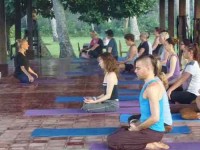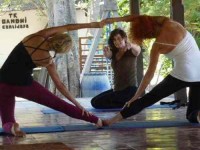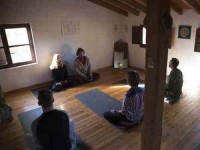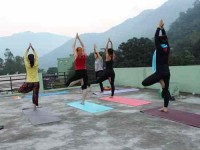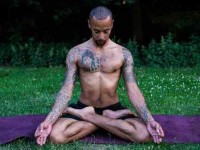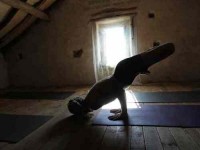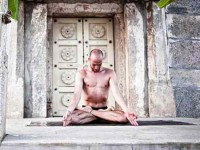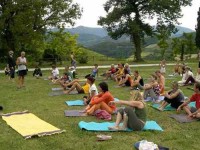Ashtanga Yoga
Astanga Yoga means ‘eight limbed yoga,’ and it is an authentic practice that can lead to liberation and greater awareness of our spiritual potential. The eight limbs of Astanga Yoga can be described as eight disciplines. They are yama, niyama, asana, pranayama, pratyahara, dharana, dhyana, and samadhi. Of these, the third limb, asana (the practice of yoga postures), is the most important for us to practice, and through it we can understand the other limbs. Though in appearance an external and physical discipline, through consistent effort we find many layers, more and more subtle, which need to be experienced directly and can lead to the experience of the last four limbs. Yama (restraints) and niyama (observances) should be observed at all times, otherwise yoga asana practice is reduced to a purely physical pursuit. Pranayama (breath control) should only be taught after mastering asanas, when the nervous system is strengthened and prepared for more rigorous practice. The last four limbs are pratyahara (withdrawal of the senses), dharana (concentration), dhyana (meditation), and samadhi (blissful union). These final four are considered ‘internal limbs,’ meaning that they arise spontaneously as a result of practice of the first four and lead to the experience of ‘union.’
Through asana we can access higher levels of yoga and, over time, bring both the body and mind to a state of stability, a state of peace. With consistent practice of asanas, changes become apparent on many levels, physical and mental. A deep sense of contentment and inner peace arises, and it is only then that we can understand the other seven limbs of Astanga Yoga.
The Astanga Yoga method taught by Shri K. Pattabhi Jois focuses first on the practice of asanas in order to establish health, to correct imbalances, and to strengthen the system, thus stabilizing the body and mind, without which we are unable to control our sense organs. The mind is said to be like a monkey. It is ‘cañcala,’ meaning that it jumps from one place to the next, never staying still. Through the discipline of asana practice, done consistently over time, we are able to bring ‘sthira’ (stability) to the body and mind. We then come to a state in which we can experience the true meaning of yoga. In this way, asana practice is the foundation for the other limbs of yoga, and without its practice we are not able to obtain the necessary sthira. To understand the profound effect of this asana practice, it must be experienced directly, through regular practice, over a long time. Then, in yoga, we become like the diver who can see the rich and vast beauty of the ocean beneath the surface, while the sailor who remains in the boat sees only that which appears on the surface. The method of asana practice prescribed by Shri K. Pattabhi Jois was taught to him by his teacher, Shri T. Krishnamacharya, and is said to have come from an ancient text, the Yoga Korunta. It relies on the linking of asanas through prescribed vinyasas (movements) and incorporates deep, even breathing and steady gazing with the eyes, or drsti.
The ‘vinyasa,’ or movement between asanas, encourages the blood to circulate properly in the body, while the deep breathing supplies a rich source of pure air, oxygenating the blood and allowing the removal of unwanted toxins through the lungs. Internal heat is produced, and is described as burning up the impurities in the body, the toxins are liberated from the tissues by each asana. The sweat that results also serves to remove toxins through the skin. ‘Drsti,’ or steady gazing in different places during each vinyasa and asana, is an important element of the practice, which over time facilitates dhyana (meditation), having a profound effect on the steadiness of the mind. When all of these elements are incorporated into the practice, having been learned correctly under the guidance of a qualified teacher, we are able to purify and strengthen the system, making the body light and strong, and the mind calm and peaceful. We are then able to realize the full benefits of the practice and dive deeply into the ocean of yoga.
- Anusara Yoga
- Aqua yoga
- Ashtanga Yoga
- Ayurveda Yoga
- Bhakti Yoga
- Bihar Yoga
- Bikram / Hot Yoga
- Dynamic Yoga
- Hatha Yoga
- Himalayan yoga
- Hridaya yoga
- Integral yoga
- Iyengar Yoga
- Jivamukti Yoga
- Kripalu Yoga
- Kriya Yoga
- Kundalini Yoga
- NEW INDIA
- Nidra Yoga
- Power Yoga
- Restorative Yoga
- Sivananda Yoga
- Tantra Yoga
- Taoist yoga
- Vinyasa Yoga
- Yin Yoga
- Yoga flow
- All yoga retreats
- DESTINATION: India +
- Costa Rica
- Greece
- Indonesia
- Italy
- Mexico
- Morocco
- Portugal
- Spain
- Thailand
- Turkey
- USA


